There are lots of great interviews out there about game localization that have faded into obscurity over the years, so I’ve started to build a collection of them to share with others. If you know of any other good interviews, let me know!
Interview
This interview comes from the September 1994 issue of Super Play Magazine, a British Super NES magazine from the 1990s. In it, Ted Woolsey – Squaresoft’s famous Japanese-to-English translator – discusses his experiences translating some high-profile games, as well as some inside info about other projects that were in the works.
Square Games in Europe
Super Play: Up until the release by Nintendo UK of the insanely great Secret of Mana, European players will only ever see the wonder of Square games by obtaining grey import cartridges. Is this the start of more officially released Square games to come, or a one-off deal purely for the launch of the Secret of Mana?
Ted Woolsey: No, there are definitely more Square games planned for release in Europe. This process of releasing games through other people is pretty much the same strategy that our parent company in Japan used when first breaking into the American market. They didn’t set up a company here straightaway and market our games direct, instead they licensed the first 8-bit Final Fantasy game to Nintendo and eased into the US market gradually. I’m sure that this is the same strategy now, but in Europe.
Super Play: So it would seem likely that Squaresoft’s presence in Europe will increase, maybe until a Squaresoft Europe is established?
Ted: Well that would seem sensible because the European market is very strong and it looks likely that it will only increase, but I think it’s too early to tell if there will be a Square office set up. Either way, the games will keep coming though…
Choosing Which Games to Translate
Super Play: Tell us about your relationship will Square of Japan. Do you choose which of their games will be translated into English, or do they tell you?
Ted: It’s getting more to a point where we do actually have a lot of control. In the early days – about five years ago – titles were selected in Japan for American release, “localised” [translated and re-jigged for the new audience], and then shipped over for release. But at the end of this month, I’ll be going over to Square in Japan to take a look at all the titles in development and hand-pick which games we’re going to release in the US and Europe over the next year.
So more and more we’re having a hand in deciding which games make it out of Japan.
Super Play: And this responsibility will increase, right?
Ted: Absolutely.
Sizing Up the Competition
Super Play: Things are really on a roll for Square right now. It seems that Final Fantasy is now a serious rival to Dragon Quest for the crown of most popular RPG series in Japan. In America, though, Enix still has a loyal following. Do you think the next few releases from Square will consolidate your position as a leader in the field? Do you feel you are in a battle with Enix?
Ted: Hmm, not really. It’s funny over here in the US because role playing games are such a small slice of the overall videogaming pie, the following is still very much a minority of gameplayers. Our research has shown that if someone has a positive experience playing a role playing title, then they want more. So people who like, say, a Dragon Warrior title seem to like Squaresoft titles as well. I know that there are big sales battles going on in Japan between Square and Enix, and I think that they actually have some sort of agreement not to go head-to-head with the release of similar titles and to make sure that both Square and Enix have enough space, but over here in the US, it’s a whole lot more relaxed.
Over here I really don’t think that it’s a negative thing to have two very strong RPG lines.
Super Play: You’re saying that yourselves and Enix are actually doing each other favours: making sure that RPG fans have a decent supply of quality titles enabling the genre to grow and gain more support?
Ted: Yeah, absolutely.
Super Play: Do you take much notice of releases from other companies, and follow gaming trends? Or does Square stick to its own guns and try not to be swayed by current trends?
Ted: No, no – in this day and age it’s impossible to shut your eyes and ignore what’s going on around you. We’re very careful to look and watch what’s coming out and when stuff’s being released also.
Challenges of Game Translation
Super Play: On a scale of one to ten, how tough is it to translate Japanese games into English?
Ted: Let me put it this way, it’s a lot more difficult than it seems! Our avid following here in the US is constantly saying to us, “look, just what is your problem? Get the games out faster!”, they have a real problem with this. But they don’t understand that there are severe limitations – as everyone who’s played a Square game will realise – with size, it’s just so tough squeezing the translated text into the game. What this means is that you have to rethink an entire plot without actually changing any of the parameters that govern how the plot has implications on the rest of the game. So inevitably some depth is lost in the translation from Japanese to English.
Super Play: How much is lost?
Ted: Well, as far as simple text is concerned, I would say that you can get twice as much information in the same space when written in Japanese as you can writing in English. But it’s the process of making sure that what you’re left with still makes complete sense, that’s the real time consuming problem, even after you’ve stretched and pulled all the text windows until they are as big as possible. Also, with some titles – like the Secret of Mana – there’s no order to the messages. As a result, it’s very difficult to get any sense of storyline when you’re trying to do the translation; all you can see at any one time are a bunch of disjointed text windows. It’s actually very difficult keeping all the plot lines and story elements in your head while working out what can be lost and what needs to be changed.
Translating Japanese can be a completely frustrating task!
Cultural Differences in Translation
Super Play: Aside from the basic difference in languages, do you experience a lot of problems when you’re dealing with distinctly Japanese cultural points or cultural references?
Ted: Oh yes. And a lot of the problem lies with the basic expectations of the gameplayer. Japanese RPGs come from a textual background; from short stories, manga, and novels. In Japanese literature, typically, the need for a strong beginning, middle, and end is not that great. The Japanese tend to savour the episodic elements of an adventure; brief jaunts off on side-quests which bear no relation to the main game are welcome in Japan, but here in the US – and I guess in Europe too – players tend to react like “Now what was all that for? What a waste of time!”. So in some ways it’s difficult to translate a game that was designed for the Japanese market because the gameplayers themselves are very different – it’s not just that they speak a different language.
Super Play: So how do you deal with this kind of problem? Do you have the facilities in the US to restructure a game to suit tastes outside of Japan?
Ted: Well we have the know-how – that’s not a problem – but we’re really up against tough time constraints. In a perfect world, we would take the beautiful graphics we get from Japan and completely dump all of the code that stipulates when an event has to happen and how it occurs. We would go back in and tailor it to the audience here.
But back in the real world we simply don’t have the time or resources to do this. We have to take it exactly as it comes and simply dump the English translation into the original game.
Super Play: So you’d still keep the graphics!
Ted: Oh yes! While the actual game code may be in no way superior to stuff generated in America or Europe, the Japanese do have a beautiful sense of style and I think the games (especially Final Fantasy III, which is Final Fantasy VI in Japan) are absolutely beautiful with scanned images overlaid on built-up graphics.
Game Translation Process
Super Play: So how do you go about actually translating a game? What process is involved?
Ted: I was given just 30 days to translate the Secret of Mana text. This meant that I had to fly out to Japan for a month with my wife and kids and just get on with translating the original scripts practically just as soon as they were completed. There’s really no time to do justice to these games.
Super Play: So do you normally wait until a game is finished before starting on the translation or work side-by-side with the people writing the original storyline?
Ted: No, I usually wait for a finished product and that’s because if I jump in and start taking on text before the game is finished, there will be inevitably so many – countless – revisions and rewrites of the original that my translation becomes out of date practically as soon as I’ve completed it. The people who write these games work right until the last minute to hone the text to perfection, and as the text changes then so do the graphics, the timing of animated sequences, and indeed the storyline. So it really does pay to wait until the game is done and then jump in and get on with it.
Super Play: How do you co-ordinate the dialogue with hundreds of difference characters?
Ted: I play the finished Japanese version about three times then, having video-taped all the appearances of characters, I’ll sit down and work out a translation that seems to work in English but will also work with all the original Japanese source code. Then, if there’s time, I can start adapting the game to more non-Japanese tastes.
Game Design & “Secret of Mana 2”
Super Play: Secret of Mana’s wide appeal might be put down to its action-based combat, players don’t have to worry too much about weapon stats and the like if they don’t want to. Many older gamers prefer turn-based combat, however, and the slower, more involved plots. Which do you favour? Are there more action RPGs on the way from Square?
Ted: Well, Secret of Mana 2 will be an action/adventure title, as will our first US-developed game; both of which are currently under development. This US game is being done by Americans, so it would seem logical that it will follow the more popular action/adventure format.
As regards to which is the better system… Well, there are maniacal players of the command-driven RPGS and these people will dabble in action games, such as Zelda, but they always actually prefer the slower-paced, more strategic traditional games. We receive telephone calls from strange people many years after a game was released, calling to find out if the game hero ever got married! Now these are the real maniacal players.
The action/adventure players, however, are larger in numbers and the demographic is different. They tend to be younger and like the idea of jumping straight into the action with a sword in their hands; it’s an empowerment issue – you get to go out there, start whacking things, and it feels good!
With the more traditional RPGs, it takes a good 15 or 20 hours of playing before you’re finally hooked.
Super Play: So I guess there’s always a compromise to be faced when putting a game interface together or designing a combat system. Do you appease the diehard fans who like to “go deep”, or make the game more accessible to a larger audience?
Ted: Exactly. It’s definitely a trade-off and it’s a tough one. But I think Secret of Mana went a long way into bringing more RPGs into the mix than perhaps, say, Zelda which is more predominantly a straightforward action game.
Content Reduction & Super NES CD-ROM
Super Play: You must be very pleased with the reception to Secret of Mana. This game has caused jaded reviewers to blub with joy, with its sumptuous graphics and perhaps the greatest musical score of any Super NES game ever. Did you know it was going to be such a success?
Ted: Well, no – there’s an interesting story here in that Secret of Mana was originally scheduled as a CD game for the Sony CD-ROM SNES add-on that never appeared. So it probably would have been much longer, and I think that when you play it you can get a sense of areas where it seems that something might be missing… But the team working on it turned it back into a cartridge game and I think they did a wonderful job; certainly the graphics speak for themselves.
But as to whether we knew it was going to be a success, well no. In Japan, the game certainly didn’t sell very well up against the Final Fantasy series (which was in its sixth iteration, whereas Secret of Mana was starting off with no momentum) so no one was expecting the runaway hit that it’s turned out to be.
Super Play: Is there anything missing from the English version?
Ted: No, just some things have been altered for the sake of space.
Final Fantasy V
Super Play: Final Fantasy VI is going to be released as Final Fantasy III in the US, with Final Fantasy V being held over ’till 1995 to be released as a separate game. Could you explain this decision, and tell us about the games themselves?
Ted: The Final Fantasy series basically has two separate tracks: the odd series (Final Fantasy I, Final Fantasy III, and Final Fantasy V) are controller command drive games, whereas the even series are more storyline driven games. As for Final Fantasy V though, well although we’re sure it’s a great title, it hasn’t been a hit with too many people in our focus groups, although experienced gamers loved the complex character building – it’s just not accessible enough to the average gamers. But, we’re determined we want to release it so we’re going to wait and introduce it once there’s a larger audience for its particular style. Hence the wait.
Super Play: Is there a finalised name for Final Fantasy V yet?
Ted: The tentative, working title at the moment is “Final Fantasy Extreme”. But this could always change…
Changes in Final Fantasy IV
Super Play: Final Fantasy II also had some changes (we’ve heard rumors about the dancers stripping off in the original!). Tell us about those, go on.
Ted: Well, there’s a level of playfulness and – dare I say – sexuality in Japanese games that doesn’t exist here [in the USA], basically because of Nintendo of America’s rules and guidelines. And this includes little characters that take their clothes off, or show their bottoms or chests – that Nintendo won’t allow over here. I guess the aesthetic in Japan is perhaps similar to that found in say France or Germany, where you might see more people nude sunbathing or – in magazines perhaps – see more “anatomical” shots. I mean, in the original there was nothing shocking – there was no sex or anything – but what there was Nintendo didn’t like so we had to remove it.
Super Play: Maybe the new, more lenient Nintendo would now allow this…
Ted: Yes, it’s certainly possible that in the future there will be a completely uncut version released.
Square, Capcom, and Breath of Fire
Super Play: Square has picked up Capcom’s Breath of Fire for translation and a US release is planned for August of this year. What prompted you to make this move?
Ted: Actually Capcom approached us. They had a very busy schedule (that included at least two RPGs) so simply didn’t have room for it. And we loved it, and knew it to be something our audience was dying for…
Romancing SaGa 2
Super Play: What about Romancing SaGa 2? Have you any plans to translate this? It did remarkably well in Japan, and its similarities to the Final Fantasy series would make it extremely popular with fans of those games…
Ted: Oh yeah, I’m sure it would be great but unfortunately it all comes down to a manpower issue and we really don’t have the resources to do it. For every person put onto the job of restructuring a game for an English translation, it means one taken off the development of Final Fantasy VII or Secret of Mana 2. So no, unfortunately, I can’t see the Romancing SaGa series making it over here.
Live A Live
Super Play: A new 16-meg RPG called Live A Live is shortly to be released in Japan. Have you any plans to bring this over too? We understand that it contains a little strategy game called Captain Square, and few strategy games have made it to the West.
Ted: Oh, yes this is a great game. It’s been designed by one of the team behind Hanjuku Hero from a couple years ago and it’s basically seven games crammed into one 16-meg cart – so each are graphically quite simple, but great games.
The trouble is that up against Mortal Kombat, for example, gamers really demand more visual sophistication – so it’s fairly doubtful that we could ever sell enough to get our money back.
Mysterious Faces
Super Play: That’s a shame. Maybe one day the audience will be big enough to make it worthwhile. Just one last thing: the faces that appear in the backgrounds of a lot of your games – what are they all about, is there a hidden message here?
Ted: Everyone seems curious about the faces! But no, there’s no hidden meaning, satanic messages, or anything – I guess it’s just our artists’ sense of bizarre humour coming to the fore. Actually, in one of the deep dungeons in Final Fantasy II, there was a room that contained the entire programming team. Unfortunately, that was one thing that just didn’t make it across to the US version. Nintendo didn’t seem to appreciate it.
Super Play: Spoilsports. Well, here’s wishing you the best of luck with your future titles, Ted, and pick out some good ones for us when you visit Japan. Thanks very much for your time.

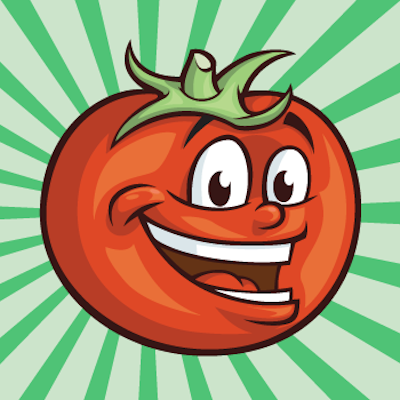
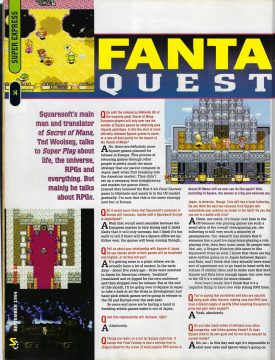
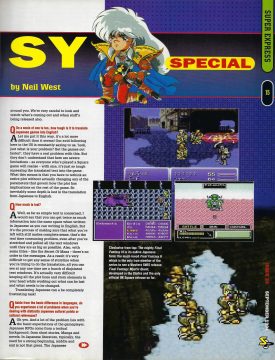
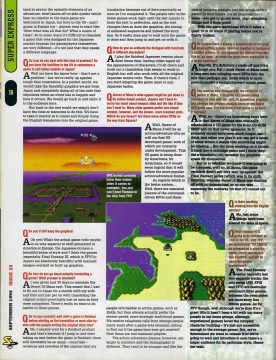
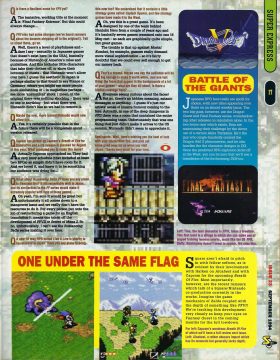
![press start to translate [Final Fantasy IV] press start to translate [Final Fantasy IV]](https://legendsoflocalization.com/wp-content/uploads/2019/08/bbenma.png)
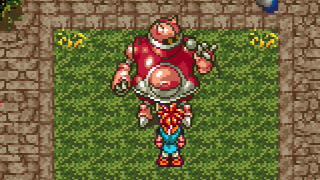
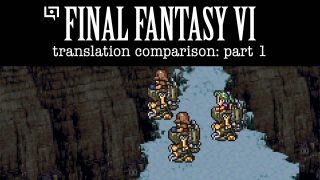

“In a perfect world, we would take the beautiful graphics we get from Japan and completely dump all of the code that stipulates when an event has to happen and how it occurs. We would go back in and tailor it to the audience here.”
Imagine the flame wars if they’d ever actually done this. American vs Japanese version fans would be fighting for decades.
That reminds me – back when Working Designs was, uh, “handling” Vay (an obscure JRPG for the Sega CD), they actually did exactly what Woolsey mentions here and altered an event partway through the game. There’s one NPC, a wind fairy named Sylph/Sirufa, who uses her magic powers to transport the party to various locations. In the Japanese version, her dialogue is straightforward. You just talk to her and she uses her wind magic to warp you and that’s that.
In the US version though.
god dammit.
In the US version, Sirufa lost a bet with “Thaldar”, whoever that is, and was cursed with “eternal seismic flatulence” as a result. So now her wind magic is extremely noxious farts. So noxious that if every single person in your party is not equipped with a Filtration Mask (renamed from the Japanese version’s Bronze Armor), you’ll pass out and get a game over.
…yeah. It didn’t go over well. (And the less said about the gold vortex, the better.)
Some days WD was better than others. That wasn’t one of their finer moments.
…
It was hilarious, though.
Yeah, sometimes WD was just bad rather than terribad.
Isn’t this what Secret of Evermore is compared to the actual “Secret of Mana 2”? Takes the general gameplay and some of the graphics and tailor all of the rest from scratch to whatever the local audiences considers as their comfort zone. Ted Woolsey himself was working on a new N64 JRPG from scratch that got cancelled.
I prefer original americanized sequels to trying to do that during the process of localization without enough budget or regard to consistency.
I think this is the first I’ve heard about “faces that appear in the backgrounds of a lot [Square] games”, wonder what they’re refering to.
Methinks it’s a reference to Moai face running gag/easter egg thing
https://finalfantasy.fandom.com/wiki/Moai
“Ted: Well we have the know-how – that’s not a problem – but we’re really up against tough time constraints. In a perfect world, we would take the beautiful graphics we get from Japan and completely dump all of the code that stipulates when an event has to happen and how it occurs. We would go back in and tailor it to the audience here.”
What an absolutely frightening prospect. There but for the grace of God go we.
This was mildly depressing to read, seeing so many great RPGs mentioned and so few of them actually receiving SNES localizations. I really love Live-A-Live though. I really hope Square localizes it in some form someday.
Man, those were some seriously tough times in the gaming industry. It’s obvious RPGs were not a high point of many North American gamers until FFVII entered the scene and changed everyone’s views of the genre.
Still can’t believe Ted had only thirty days to translate Secret of Mana. That must have been an awful crunch.
So, on that trip he saw the games in development. Assuming all of the 1995 games were (Wikipedia says Super Mario RPG didn’t go into heavy development until 1995, so it’s likely at that time there was nothing to see)
Chrono Trigger, which he chose for localization
MAYBE Front Mission (which was developed by an outside company and published by Square.) If he did see it, maybe it was too complicated for western audiences who couldn’t even handle FF5
Seiken Densetsu 3. I’ve heard that Evermore didn’t stop this from coming over, but not really sure on that. If Evermore was Mana 2 at this point, it makes me think that Seiken 3 was passed over because you can’t have 2 Secret of Mana 2s out there
Interesting that Romancing Saga 3 was passed over. The preceding two were passed over. He said 2 not coming was a manpower issue, but more than once they did pluralize games when he said he was going to pick some out. Wonder why they decided not to do Saga 3? Cutting manpower further?
Sadly many localized SNES games from Square never get released in Europe. One reason is that PAL games run at 50 frames per second and scenes where the music matches the animation will start to desync and break. (eg FFIII ending)
“Ted: The Final Fantasy series basically has two separate tracks: the odd series (Final Fantasy I, Final Fantasy III, and Final Fantasy V) are controller command drive games, whereas the even series are more storyline driven games. ”
Wow. This really opened my eyes. I feel like I learned something secret that’s been there the whole time and wasn’t ever talked about (to my knowledge – or, I knew and forgot).
I can actually understand why they didn’t bring FFV over now. I’m the IV and VI type, when I got to play V I just didn’t get the feel for it that I’d been expecting, and thinking of it as a less story driven game type makes sense of that feeling. It also makes me think of how VII was big in America but I rolled my eyes at first, and how I didn’t like XIII or XV at all. Apparently, their second MMORPG is actually hugely story driven, too. It seemed confusing to me why it would get that attention before, but this pattern interests me now. When they’re done procrastinating and remaking seven, maybe they’ll do another game that’s more my style????? Okay, admittedly, I haven’t played past VIII anyway. I watched some but nothing past that elicited emotional reactions from me.
Oh, also, I had thought “Well hey, when they remake VII, maybe they’ll add to the story and characters stuff that they didn’t have time for before”, then they showed the gameplay and that it would be released in separate sections and I COMPLETELY lost interest. Apparently it WILL have a classic fight mode though, so I won’t have to waste my time with unnecessary special controls relying on my decaying motor skills… if I play it.. I guess.. I was going to… I dunno.